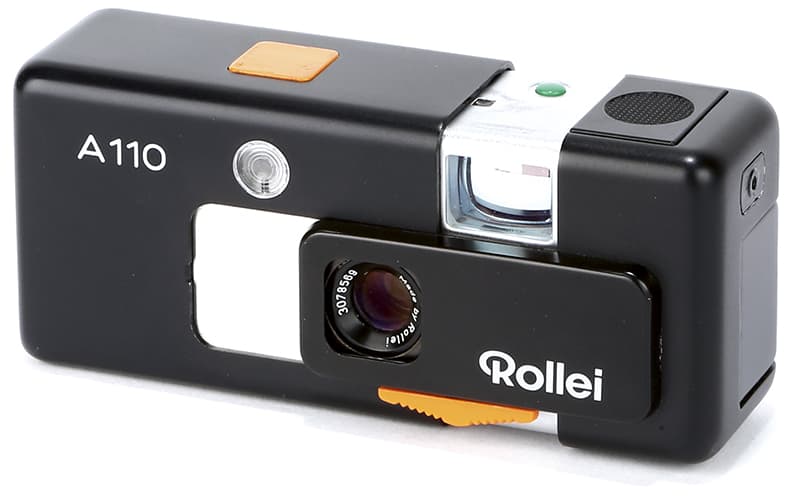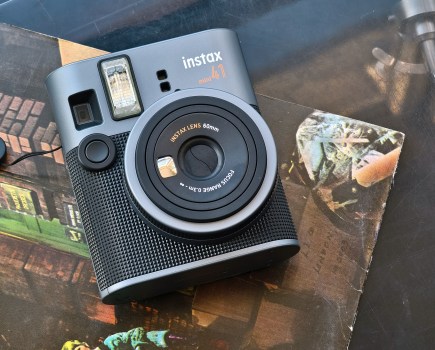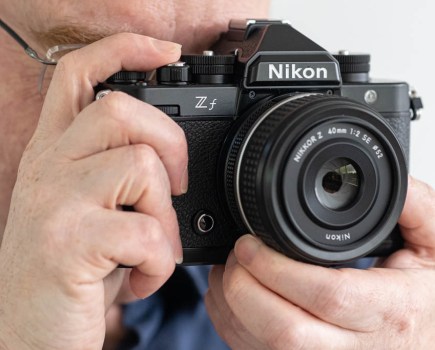Yashica Electro 35 GTN
Price: £30
 The Yashica Electro 35 GTN and its sister, the GSN, have developed something of a following. They have been called the poor man’s Leica, and while this is clearly wishful thinking, there is a passing resemblance to the later M-series Leicas. Available in black or chrome, if nothing else they do make a stylish fashion accessory.
The Yashica Electro 35 GTN and its sister, the GSN, have developed something of a following. They have been called the poor man’s Leica, and while this is clearly wishful thinking, there is a passing resemblance to the later M-series Leicas. Available in black or chrome, if nothing else they do make a stylish fashion accessory.
The f/1.7 lens, together with a coupled rangefinder, means you can fully exploit the narrow depth of field in low light at full aperture. Potential problems with obtaining batteries have several work-arounds – you could buy an adapter, but a quick Google search will show you how to do it yourself.
Rollei A110
Price: £20-£30
 The first thing that comes to mind when most people think about 110 cameras is the inexpensive and basic pocket Instamatic variety. However, most major manufacturers dipped their toes into the high-spec end of the 110 camera market, and there are some very nice, and now, thanks to the return of 110 film, very usable models to be found.
The first thing that comes to mind when most people think about 110 cameras is the inexpensive and basic pocket Instamatic variety. However, most major manufacturers dipped their toes into the high-spec end of the 110 camera market, and there are some very nice, and now, thanks to the return of 110 film, very usable models to be found.
The Rollei A110 is a little gem. When closed, the metal body feels solid and robust, yet with its rounded corners it fits snugly in the palm of the hand. The f/2.8 Tessar lens has scale focusing, but there are no other adjustments to make, as the programmed electronic shutter takes care of everything else. The shutter will stay open for as long as 4secs if the light levels require it.
Franka Solida II
Price: £15-£30
If you fancy a taste of medium format, there’s no need to break the bank. The Franka Solida is typical of the folding 6x6cm models that were the mainstay of hobby photography in the 1950s. Many permutations of lens and shutter were made. This one has a crisp 80mm f/3.5 Schneider Xenar lens and the Prontor SVS shutter, which has the full range of speeds from 1/300sec down to 1sec.
When folded, it can slip into a coat pocket, and makes an ideal holiday camera if you want to shoot medium format but are only carrying hand luggage.
Agfa Parat 1
Price: £10-£20
 Half a century ago, when film was expensive, the half-frame format became quite popular, with many manufacturers cashing in on the fact that twice as many photos could be squeezed onto a roll, albeit with a smaller negative and therefore some loss of quality.
Half a century ago, when film was expensive, the half-frame format became quite popular, with many manufacturers cashing in on the fact that twice as many photos could be squeezed onto a roll, albeit with a smaller negative and therefore some loss of quality.
Agfa introduced the Parat range in 1963. The Parat 1 is fully manual, with a limited but useful range of shutter speeds and a 30mm f/2.8 lens with zone and scale focusing. The vertical frame format makes these cameras ideal for creating simple panoramic sequences.
Contaflex I
Price: £15-£30
 The Contaflex I is one of a range of fixed-lens, leaf-shutter SLRs that Zeiss Ikon made between 1953 and 1972. There were more than a dozen models with varying degrees of sophistication. This is one of the earlier, more basic versions – automatic exposure systems came later. The shutter mechanism is quite complex, as the shutter needs to be open while you focus. Then, when the shutter release is pressed, it closes, the mirror goes up, and the shutter opens for the exposure.
The Contaflex I is one of a range of fixed-lens, leaf-shutter SLRs that Zeiss Ikon made between 1953 and 1972. There were more than a dozen models with varying degrees of sophistication. This is one of the earlier, more basic versions – automatic exposure systems came later. The shutter mechanism is quite complex, as the shutter needs to be open while you focus. Then, when the shutter release is pressed, it closes, the mirror goes up, and the shutter opens for the exposure.
Earlier models didn’t have instant return mirrors, so you had to advance the film before you could see through the viewfinder again.
Olympus XA2
Price: £10-£15
 The XA series is probably the range of cameras I use most frequently. The XA2 in particular is easily available and often very cheap. I’ve paid as little as £2 for one. Other than zone focusing there are no controls to set, but the programmed automatic electronic exposure system will cope with a wide range of conditions, with the shutter staying open for 2secs if necessary. Its pocketability and speed of use make it ideal for street photography. The specs are almost identical to the cult Lomo LC-A, but at a fraction of the price.
The XA series is probably the range of cameras I use most frequently. The XA2 in particular is easily available and often very cheap. I’ve paid as little as £2 for one. Other than zone focusing there are no controls to set, but the programmed automatic electronic exposure system will cope with a wide range of conditions, with the shutter staying open for 2secs if necessary. Its pocketability and speed of use make it ideal for street photography. The specs are almost identical to the cult Lomo LC-A, but at a fraction of the price.
If your budget will stretch to it, the XA has a f/2.8 lens with aperture priority exposure and a coupled rangefinder, while my favourite, the XA4, has a 28mm lens and focuses down to 12in (30cm). These latter two models will set you back upwards of £50. Don’t fall into the trap of getting an XA1, which is a much simpler version.






